Mustafa Kemal Ataturk - Picture
More about World War 1
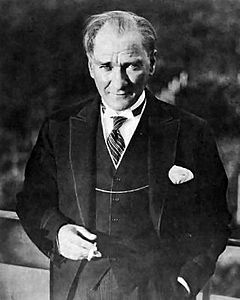
|
|
Mustafa Kemal Ataturk
Mustafa Kemal Ataturk

1 President of Turkey:
: In office
29 October 1923 - 10 November 1938
Born: indeterminate 1881 (the date 19 May 1881 was used for official purposes, but there is no certainty he was born on this day)
Selx¢nik, Ottoman Empire (present-day Thessaloniki, Greece)
Died: 10 November 1938(1938-11-10) (aged 57)
Dolmabahx§e Palace
Istanbul, Turkey
Resting place: Anıtkabir
Ankara, Turkey
Nationality: Turkish
Political party: Committee of Union and Progress, Republican People's Party
Spouse(s): Lx¢tife UÅaklıgil (1923-25)
Religion: See Mustafa Kemal Ataturk's religious views.
Signature:
: Military service
Allegiance: Ottoman Empire
(1893 - 8 July 1919)
Republic of Turkey
(9 July 1919 - 30 June 1927)
Service/branch: Army
Rank: Ottoman Empire: General (Pasha)
Republic of Turkey: MareÅal (Marshal)
Commands: 19 Division - 16 Corps - 2 Army - 7 Army - Yildirim Army Group - commander-in-chief of Army of the Government of the Grand National Assembly
Battles/wars: Tobruk - Anzac Cove - Chunuk Bair - Scimitar Hill - Sari Bair - Bitlis - Sakarya - Dumlupınar
Awards: List (24 medals)
: Graphical Timeline
Detailed Chronology
Mustafa Kemal Ataturk (indeterminate, 1881-10 November 1938) was an Ottoman and Turkish army officer, revolutionary statesman, writer, and the first President of Turkey. He is credited with being the founder of the modern Turkish state.
Ataturk was a military officer during World War I. Following the defeat of the Ottoman Empire in World War I, he led the Turkish national movement in the Turkish War of Independence. Having established a provisional government in Ankara, he defeated the forces sent by the Allies. His military campaigns gained Turkey independence. Ataturk then embarked upon a program of political, economic, and cultural reforms, seeking to transform the former Ottoman Empire into a modern, westernized and secular nation-state. The principles of Ataturk's reforms, upon which modern Turkey was established, are referred to as Kemalism.
Early life
Mustafa was born in either the Ahmed SubaÅı neighbourhood or the Islahhane Street (present-day Apostolu Pavlu Street) in the Koca Kasım Pasha neighbourhood (this house is preserved as a museum) in Selx¢nik, Ottoman Empire, to his mother Zx¼beyde Hanım (a housewife) and father Ali Rıza Efendi (a militia officer, title deed clerk and lumber trader). Only one of Ataturk's siblings, a sister named Makbule (Atadan) survived childhood; she died in 1956. According to Andrew Mango, he was born into a family which was Muslim, Turkish-speaking and precariously middle-class. Time magazine states that Mustafa Kemal's father was of Albanian and his mother was of Macedonian origin, and Patrick Kinross wrote that he was "as fair as any Slav from beyond the Bulgarian frontier" with "fine white skin" and "eyes of a deep but clear light blue." According to Encyclopaedia Judaica, one assertion that was commonly made by many Jews of Salonika was that Kemal Ataturk was of Doenmeh origin. This view was eagerly embraced by many of Ataturkâs religious opponents and denied by the Turkish government. His father Ali Rıza is thought to be of Albanian origin; however, according to Falih Rıfkı Atay, Ali Rıza's ancestors were from Sx¶ke in the Aydın Province of Anatolia. His mother Zx¼beyde is thought to be of Turkish origin and according to Åevket Sx¼reyya Aydemir, she was of Yx¶rx¼k Tx¼rkmen ancestry.
Born Mustafa, his second name Kemal (meaning Perfection or Maturity) was given to him by his Mathematics teacher, Captain xskx¼plx¼ Mustafa Efendi, according to Afet Inan in admiration of his capability and maturity, and according to Ali Fuat Cebesoy, because his teacher Mustafa Efendi wanted to distinguish his student who carried the same name with him, although his biographer Andrew Mango suggests that he may have chosen the name himself as a tribute to the nationalist poet Namık Kemal. In his early years, his mother encouraged Mustafa to attend a religious school, something he did reluctantly and only briefly. Later, he attended the Åemsi Efendi School (a private school with a more secular curriculum) at the direction of his father. His parents wanted him to learn a trade, but without consulting them, Ataturk took the entrance exam for a military junior high school in the Ottoman city of Selx¢nik (Salonika, modern Thessaloniki in Greece) in 1893. In 1896, he enrolled into a military high school in the Ottoman city of Manastır (modern Bitola, Macedonia). On March 14, 1899, he enrolled at the War College in the neighbourhood of Pangaltı within the ÅiÅli district of the Ottoman capital city Constantinople (modern Istanbul in Turkey) and graduated in 1902. He later graduated from the Military Staff College in Constantinople on 11 January 1905.
Military career
Early years
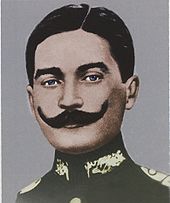
Picture - Mustafa Kemal as a Senior Captain (KolaÄası) in 1907.
Following graduation, he was assigned to the Fifth Army based in Damascus as a Staff Captain in the company of Ali Fuat (Cebesoy) and Mx¼fit (xzdeÅ). He joined a small secret revolutionary society of reformist officers led by Mustafa (Cantekin) called Vatan ve Hx¼rriyet ("Motherland and Liberty"). On June 20, 1907, he was promoted to the rank of Senior Captain (KolaÄası) and on October 13, 1907, assigned to the headquarters of the Third Army in Manastır. He joined the Committee of Union and Progress, with membership number 322, although in later years he became known for his opposition to, and frequent criticism of, the policies pursued by the CUP leadership. On June 22, 1908, he was appointed the Inspector of the Ottoman Railways in Eastern Rumelia (DoÄu Rumeli Bx¶lgesi Demiryolları Mx¼fettiÅi). In July 1908, he played a role in the Young Turk Revolution which seized power from Sultan Abdx¼lhamid II and restored the constitutional monarchy.
In 1910 he was called to the Ottoman provinces in Albania. At that time Isa Boletini was leading Albanian uprisings in Kosovo and there were revolts in Albania. In 1910 he met with Eqerem Vlora.
Later, in the autumn of 1910, he was among the Ottoman military observers who attended the Picardie army manoeuvres in France.
In early 1911, he worked at the Ministry of War (Harbiye Nezareti) headquarters in Istanbul for a short time.
Italo-Turkish War (1911-1912)
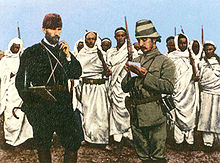
Picture - BinbaÅı Mustafa Kemal Bey (left) with a Turkish military officer and Bedouin forces in Darnah, Tripolitania Vilayet, 1912.
Later in 1911, he was assigned to the Ottoman Tripolitania Vilayet (present-day Libya) to fight in the Italo-Turkish War, mainly in the areas near Benghazi (Bingazi), Darnah (Derne) and Tobruk. A massive Italian amphibious assault force of 150,000 troops had to be countered by 20,000 Bedouins and 8,000 Turks (a short time before Italy declared war, a large portion of the Turkish troops in Libya were sent to the Ottoman province of Yemen in order to put down the rebellion there, so the Ottoman government was caught with inadequate resources to counter the Italians in Libya; and the British government, which militarily controlled the de jure Ottoman provinces of Egypt and Sudan since the Urabi Revolt in 1882, didn't allow the Ottoman government to send additional Turkish troops to Libya through Egypt; causing the Turkish soldiers like Mustafa Kemal to go to Libya either dressed as Arabs (risking imprisonment if noticed by the British authorities in Egypt), or through very few available ferries (the Italians, who had superior naval forces, effectively controlled the sea routes to Tripoli).) However, despite all the hardships, Mustafa Kemal's forces in Libya managed to successfully repel the Italians in a number of occasions, such as the Battle of Tobruk on 22 December 1911. During the Battle of Darnah on 16-17 January 1912, while Mustafa Kemal was assaulting the Italian-controlled fortress of Kasr-ı Harun, two Italian planes dropped bombs on the Ottoman forces and a piece of limestone from a damaged building's rubble entered Mustafa Kemal's left eye; which caused a permanent damage on his left eye's tissue, but not a total loss of sight. After receiving medical treatment for nearly a month (he attempted to leave the Red Crescent's health facilities early after only two weeks, but when his eye's situation worsened, he had to return and resume the treatment) on 6 March 1912 Mustafa Kemal became the Commander of the Ottoman forces in Darnah. He managed to defend and retain the city and its surrounding region until the end of the Italo-Turkish War on 18 October 1912. Mustafa Kemal, Enver Bey, Fethi Bey and the other Turkish military commanders in Libya had to return to Ottoman Europe following the outbreak of the Balkan Wars on 8 October 1912, due to which the Ottoman government agreed to surrender the provinces of Tripolitania, Fezzan and Cyrenaica (present-day Libya) to the Kingdom of Italy with the Treaty of Ouchy (First Treaty of Lausanne) signed ten days later, on October 18.
Balkan Wars (1912-1913)
On 1 December 1912, Mustafa Kemal arrived at his new headquarters on the Gallipoli peninsula and during the First Balkan War, he took part in the amphibious landing at Bulair on the coast of Thrace that was commanded by BinbaÅı Fethi Bey, but this offensive was repulsed during the Battle of Bulair by Georgi Todorov's 7 Lila Infantry Division under the command of Stiliyan Kovachev's Bulgarian Fourth Army.
In June 1913, during the Second Balkan War, he took part in the Ottoman Army forces commanded by Kaymakam Enver Bey that recovered Dimetoka and Edirne (Adrianople, the capital city of the Ottoman Empire between 1365 and 1453, thus of utmost historic importance for the Turks) together with most of eastern Thrace from the Bulgarians.
In 1913, he was appointed the Ottoman military attaché to all Balkan states (his office was in Sofia, Bulgaria) and promoted to the rank of Kaymakam (Lieutenant Colonel / Colonel) on March 1, 1914.
First World War (1914-1918)
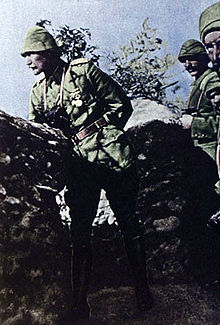
Picture - Mustafa Kemal in the trenches of Gallipoli with his soldiers, 1915.
In 1914, the Ottoman Empire entered the European and Middle Eastern theatres of World War I allied with the Central Powers. Mustafa Kemal was given the task of organizing and commanding the 19 Division attached to the Fifth Army during the Battle of Gallipoli. Mustafa Kemal became the front-line commander after correctly anticipating where the Allies would attack and holding his position until they retreated. Following the Battle of Gallipoli, Mustafa Kemal served in Edirne until 14 January 1916. He was then assigned to the command of the XVI Corps of the Second Army and sent to the Caucasus Campaign after the massive Russian offensive had reached the Anatolian key cities. On 7 August, Mustafa Kemal rallied his troops and mounted a counteroffensive. Two of his divisions captured Bitlis and MuÅ, upsetting the calculations of the Russian Command.
Following this victory, the CUP government in Constantinople proposed to establish a new army in Hejaz (Hicaz Kuvve-i Seferiyesi) and appoint Mustafa Kemal to its command, but he refused the proposal and this army was never established. Instead, on 7 March 1917, Mustafa Kemal was promoted from the command of the XVI Corps to the overall command of the Second Army, although the Czar's armies were soon withdrawn when the Russian Revolution erupted.
In July 1917 he was appointed to the command of the Seventh Army, replacing Fevzi Pasha on 7 August 1917, who was under the command of the German general Erich von Falkenhayn's Yildirim Army Group (after the British forces of General Edmund Allenby captured Jerusalem in December 1917, Erich von Falkenhayn was replaced by Otto Liman von Sanders who became the new commander of the Yıldırım Army Group in early 1918.) Mustafa Kemal Pasha could not get along well with General von Falkenhayn and, together with Miralay İsmet Bey, wrote a report to Grand Vizier Talat Pasha regarding the grim situation and lack of adequate resources in the Palestinian front; but Talat Pasha ignored their observations and suggestion that a stronger defensive line should be structured to the north, in Ottoman Syria (in parts of the Beirut Vilayet, Damascus Vilayet and Aleppo Vilayet), with Turks rather than Germans in command. Following the rejection of his report, Mustafa Kemal resigned from the Seventh Army and returned to Constantinople. There, he was assigned with the task of accompanying the crown prince (and future sultan) Mehmed Vahideddin during his train trip to Austria-Hungary and Germany. While in Germany, Mustafa Kemal visited the German lines in the west European front and came to the conclusion that the Central Powers would soon lose the war. He did not hesitate to openly express this opinion to Kaiser Wilhelm II and his high-ranking generals in first person. During the return trip, he briefly stayed in Karlsbad and Vienna for medical treatment.
When Mehmed VI became the new Sultan of the Ottoman Empire in July 1918, he called Mustafa Kemal to Constantinople, and in August 1918 assigned him to the command of the Seventh Army in Palestine. Mustafa Kemal arrived in Aleppo on 26 August 1918, then continued south to his headquarters in Nablus. The Seventh Army was holding the central sector of the front lines. On September 19, at the beginning of the Battle of Megiddo, the Eighth Army was holding the coastal flank, but fell apart and Liman Pasha ordered the Seventh Army to withdraw to the north in order to prevent the British from conducting a short envelopment to the Jordan River. The Seventh Army retired towards the Jordan River in fair order and, according to the Armistice of Mudros, signed on October 30, 1918, all German and Austro-Hungarian troops in the Ottoman Empire would be given ample time to withdraw. On October 31, he was appointed to the command of the Yıldırım Army Group, replacing Liman von Sanders. He organized the distribution of weapons to the civilians in Antep in case of a defensive conflict against the invading Allies.
Kemal's last active service in the Ottoman Army was organizing the return of the troops left behind to the south of this line. In early November 1918 the Yıldırım Army Group was officially dissolved and Mustafa Kemal returned to an occupied Constantinople, the Ottoman capital, on 13 November 1918. For a period he worked at the headquarters of the Ministry of War (Harbiye Nezareti) in Constantinople and continued his activities in this city until 16 May 1919. Along the established lines of the partitioning of the Ottoman Empire, the Allies (British, Italian, French and Greek forces) occupied Anatolia. The occupation of Constantinople, which was followed by the occupation of İzmir (the two largest Turkish cities in that period) sparked the establishment of the Turkish national movement and the Turkish War of Independence.
Turkish War of Independence (1919-1922)
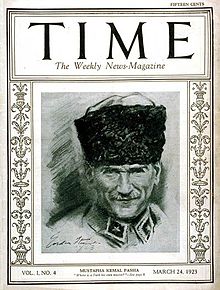
Picture - TIME 24 March 1923. Ataturk, the title reads 'Where is a Turk his own master?'
Fahri Yaver-i Hazret-i Åehriyari ("Honorary Aide-de-camp to His Majesty Sultan") Mirliva Mustafa Kemal Pasha was assigned as the inspector of the Ninth Army Troops Inspectorate to reorganize what remained of the Ottoman military units and to improve internal security on April 30, 1919. On 19 May 1919, he reached Samsun. His first goal was the establishment of an organized national resistance movement against the occupying forces. In June 1919, he issued the Amasya Circular, declaring the independence of the country was in danger. He resigned from the Ottoman Army on 8 July and the Ottoman government issued a warrant for his arrest. Later, he was condemned to death.
The last election to the Ottoman parliament held in December 1919 gave a sweeping majority to candidates of the "Association for Defense of Rights for Anatolia and Roumelia (Anadolu ve Rumeli Mx¼dafaa-i Hukuk Cemiyeti)", headed by Mustafa Kemal, who himself remained in Ankara. The fourth (and last) term of the Parliament opened in Constantinople on 12 January 1920. It was dissolved by British forces on 18 March 1920, shortly after it adopted the Misak-ı Milli ("National Pact"). Mustafa Kemal called for a national election to establish a new Turkish Parliament seated in Ankara - the "Grand National Assembly" (GNA). On 23 April 1920, the GNA opened with Mustafa Kemal as the speaker; this act effectively created the situation of diarchy in the country.
On 10 August 1920, the Ottoman Grand Vizier Damat Ferid Pasha signed the Treaty of Sx¨vres, finalizing plans for the partitioning of the Ottoman Empire, including the regions that Turkish nationals viewed as their heartland. Mustafa Kemal insisted on the country's complete independence and the safeguarding of interests of the Turkish majority on "Turkish soil". He persuaded the GNA to gather a National Army. The GNA Army faced the Caliphate army propped up by the Allied occupation forces and had the immediate task of fighting the Armenians forces in the North-East and the Greeks who advanced eastward from Smyrna (modern day Izmir) that they had occupied in May 1919.
The GNA military successes against the Democratic Republic of Armenia in the autumn of 1920 and later against the Greeks were made possible by a steady supply of gold and armaments to the kemalists from the Russian Bolshevik government from the autumn 1920 onwards.
After a series of battles during the Greco-Turkish war, the Greek army advanced as far as the Sakarya River, just eighty kilometers west of the GNA. On 5 August 1921, Mustafa Kemal was promoted to Commander in chief of the forces by the GNA. The ensuing Battle of Sakarya was fought from 23 August to 13 September 1921 and ended with the defeat of the Greeks. After this victory, on September 19, 1921, Mustafa Kemal Pasha was given by the Grand National Assembly the rank of "Marshal" and the title of "Ghazi". The Allies, ignoring the extent of Kemal's successes, hoped to impose a modified version of the Treaty of Sx¨vres as a peace settlement on Ankara, but the proposal was rejected. In August 1922, Kemal launched an all-out attack on the Greek lines at Afyonkarahisar in the Battle of Dumlupınar and Turkish forces regained control of Smyrna on 9 September 1922. On 10 September 1922, Mustafa Kemal sent a telegram to the League of Nations saying that the Turkish population was so worked up that the Ankara Government would not be responsible for massacres.
Establishment of the Republic of Turkey
The Conference of Lausanne began on 21 November 1922. Turkey, represented by Ä°smet Ä°nx¶nx¼ of the GNA, refused any proposal that would compromise Turkish sovereignty, such as the control of Turkish finances, the Capitulations, the Straits and other issues. On 24 July 1923, the Treaty of Lausanne was signed by the Powers with the GNA, thus recognising the latter as the government of Turkey.
On 29 October 1923, the Republic of Turkey was proclaimed.
Presidency
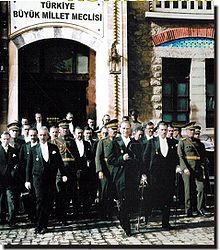
Picture - In 1930, leaving the parliament after the 7th-year celebration meeting. Ä°smet Ä°nx¶nx¼, the second President of Turkey, is to the left.
With the establishment of the Republic of Turkey, efforts to modernise the country started. The new government analyzed the institutions and constitutions of Western states such as France, Sweden, Italy, and Switzerland and adapted them to the needs and characteristics of the Turkish nation. Highlighting the public's lack of knowledge regarding Kemal's intentions, the public cheered: "We are returning to the days of the first caliphs." Mustafa Kemal placed Fevzi xakmak, Kx¢zım xzalp and Ä°smet Ä°nx¶nx¼ in political positions where they could institute his reforms. Mustafa Kemal capitalized on his reputation as an efficient military leader and spent the following years, up until his death in 1938, instituting political, economic, and social reforms. In doing so, he transformed Turkish society from perceiving itself as a Muslim part of a vast Empire into a modern, democratic, and secular nation-state.
Domestic policies
Kemal's basic tenet was the complete independence of the country. He clarified his position:
He led wide-ranging reforms in social, cultural, and economical aspects, establishing the new Republic's backbone of legislative, judicial, and economic structures.
Mustafa Kemal created a banner to mark the changes between the old Ottoman and the new republican rule. Each change was symbolized as an arrow in this banner. This defining ideology of the Republic of Turkey is referred to as the "Six Arrows", or Kemalist ideology. Kemalist ideology is based on Mustafa Kemal's conception of realism and pragmatism. The fundamentals of nationalism, populism and etatism were all defined under the Six Arrows. These fundamentals were not new in world politics or, indeed, among the elite of Turkey. What made them unique was that these interrelated fundamentals were formulated specifically for Turkey's needs. A good example is the definition and application of secularism; the Kemalist secular state significantly differed from predominantly Christian states.
Emergence of the state, 1923-1924
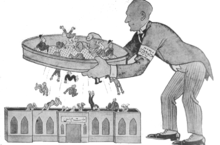
Picture - A political satire from the single-party period depicting Mustafa Kemal, the leader of the RPP, choosing the party's candidates for prospective MPs, to be elected in the incoming parliamentary elections. During the single-party state, the candidates had only one party's (RPP) list to join.
Mustafa Kemal's private journal entries dated before the establishment of the republic in 1923 show that he believed in the importance of the sovereignty of the people. In forging the new republic, the Turkish revolutionaries turned their back on the perceived corruption and decadence of cosmopolitan Constantinople and its Ottoman heritage. For instance, they made Ankara the country's new capital. A provincial town deep in Anatolia, it was turned into the center of the independence movement. Ataturk wanted a "direct government by the Assembly" and visualized a representative democracy, parliamentary sovereignty, where the National Parliament would be the ultimate source of power.
In the following years, he altered his stance somewhat; the country needed an immense amount of reconstruction, and that "direct government by the Assembly" could not survive in such an environment. The revolutionaries faced challenges from the supporters of the old Ottoman regime, and also from the supporters of newer ideologies such as communism and fascism. Mustafa Kemal saw the consequences of fascist and communist doctrines in the 1920s and 1930s and rejected both. He prevented the spread into Turkey of the totalitarian party rule which held sway in the Soviet Union, Germany and Italy. Some perceived his opposition and silencing of these ideologies as a means of eliminating competition; others believed it was necessary to protect the young Turkish state from succumbing to the instability of new ideologies and competing factions.
The heart of the new republic was the GNA, established during the Turkish War of Independence by Mustafa Kemal. The elections were free and used an egalitarian electoral system that was based on a general ballot. Deputies at the GNA served as the voice of Turkish society by expressing its political views and preferences. It had the right to select and control both the government and the Prime Minister. Initially, it also acted as a legislative power, controlling the executive branch and, if necessary, acted as an organ of scrutiny under the Turkish Constitution of 1921. The Turkish Constitution of 1924 set a loose separation of powers between the legislative and the executive organs of the state, whereas the separation of these two within the judiciary system was a strict one. Mustafa Kemal, then the President, occupied a powerful position in this political system.
The single-party regime was established de facto in 1925 after the adoption of the 1924 constitution. The only political party of the GNA was the "Peoples Party", founded by Mustafa Kemal in the initial years of the independence war. On 9 September 1923 it was renamed the Republican People's Party (Turkish Cumhuriyeti Halk Partisı).
Civic independence and the Caliphate, 1924-1925
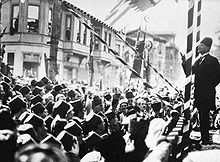
Picture - In 1924, during his speech in Bursa.
Abolition of the Caliphate was an important dimension in Mustafa Kemal's drive to reform the political system and to promote the national sovereignty. By the consensus of the Muslim majority in early centuries, the caliphate was the core political concept of Sunni Islam. Abolishing the sultanate was easier because the survival of the Caliphate at the time satisfied the partisans of the sultanate. This produced a split system with the new republic on one side and an Islamic form of government with the Caliph on the other side, and Kemal and Ä°nx¶nx¼ worried that "it nourished the expectations that the sovereign would return under the guise of Caliph." Caliph Abdx¼lmecid II was elected after the abolishment of the sultanate (1922).
The caliph had his own personal treasury and also had a personal service that included military personnel; Mustafa Kemal said that there was no "religious" or "political" justification for this. He believed that Caliph Abdx¼lmecid II was following in the steps of the sultans in domestic and foreign affairs: accepting of and responding to foreign representatives and reserve officers, and participating in official ceremonies and celebrations. He wanted to integrate the powers of the caliphate into the powers of the GNA. His initial activities began on 1 January 1924, when Ä°nx¶nx¼, xakmak and xzalp consented to the abolition of the caliphate. The caliph made a statement to the effect that he would not interfere with political affairs. On 1 March 1924, at the Assembly, Mustafa Kemal said
On 3 March 1924, the caliphate was officially abolished and its powers within Turkey were transferred to the GNA. Other Muslim nations debated the validity of Turkey's unilateral abolition of the caliphate as they decided whether they should confirm the Turkish action or appoint a new caliph. A "Caliphate Conference" was held in Cairo in May 1926 and a resolution was passed declaring the caliphate "a necessity in Islam", but failed to implement this decision.
Two other Islamic conferences were held in Mecca (1926) and Jerusalem (1931), but failed to reach a consensus. Turkey did not accept the re-establishment of the caliphate and perceived it as an attack to its basic existence; while Mustafa Kemal and the reformists continued their own way.
The removal of the caliphate was followed by an extensive effort to establish the separation of governmental and religious affairs. Education was the cornerstone in this effort. In 1923, there were three main educational groups of institutions. The most common institutions were medreses based on Arabic, the Qur'an and memorization. The second type of institution was idadx® and sultanx®, the reformist schools of the Tanzimat era. The last group included colleges and minority schools in foreign languages that used the latest teaching models in educating pupils. The old medrese education was modernized. Mustafa Kemal changed the classical Islamic education for a vigorously promoted reconstruction of educational institutions. Kemal linked educational reform to the liberation of the nation from dogma, which he believed was more important than the Turkish war of independence.
In the summer of 1924, Mustafa Kemal invited American educational reformer John Dewey to Anakara to advise him on how to reform Turkish education. His public education reforms aimed to prepare citizens for roles in public life through increasing the public literacy. He wanted to institute compulsory primary education for both girls and boys; since then this effort has been an ongoing task for the republic. He pointed out that one of the main targets of education in Turkey had to be raising a generation nourished with what he called the "public culture". The state schools established a common curriculum which became known as the "unification of education."
Unification of education was put into force on 3 March 1924 by the Law on Unification of Education (No. 430). With the new law, education became inclusive, organized on a model of the civil community. In this new design, all schools submitted their curriculum to the "Ministry of National Education", a government agency modelled after other countries' ministries of education. Concurrently, the republic abolished the two ministries and made clergy subordinate to the department of religious affairs, one of the foundations of secularism in Turkey. The unification of education under one curriculum ended "clerics or clergy of the Ottoman Empire", but was not the end of religious schools in Turkey; they were moved to higher education until later governments restored them to their former position in secondary education after Mustafa Kemal's death.
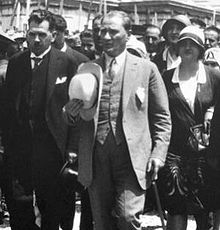
Picture - Ataturk with his Panama hat just after the Kastamonu speech in 1925.
Beginning in the fall of 1925, Mustafa Kemal encouraged the Turks to wear modern European attire. He was determined to force the abandonment of the sartorial traditions of the Middle East and finalize a series of dress reforms, which were originally started by Mahmud II. The fez was established by Sultan Mahmud II in 1826 as part of the Ottoman Empire's modernization effort. The Hat Law of 1925 introduced the use of Western-style hats instead of the fez. Mustafa Kemal first made the hat compulsory to civil servants. The guidelines for the proper dressing of students and state employees were passed during his lifetime; many civil servants adopted the hat willingly. In 1925, Mustafa Kemal wore his "Panama hat" during a public appearance in Kastamonu, one of the most conservative towns in Anatolia, to explain that the hat was the headgear of civilized nations. The last part of reform on dress emphasized the need to wear modern Western suits with neckties as well as Fedora and Derby-style hats instead of antiquated religion-based clothing such as the veil and turban in the Law Relating to Prohibited Garments of 1934.
Even though he personally promoted modern dress for women, Mustafa Kemal never made specific reference to womenâs clothing in the law, as he believed that women would adapt to the new clothing styles of their own free will. He was frequently photographed on public business with his wife Lx¢tife UÅaklıgil, who covered her head in accordance with Islamic tradition. He was also frequently photographed on public business with women wearing modern Western clothes. But it was Ataturk's adopted daughters, Sabiha Gx¶kx§en and Afet Ä°nan, who provided the real role model for the Turkish women of the future. He wrote: "The religious covering of women will not cause difficulty ... This simple style [of headcovering] is not in conflict with the morals and manners of our society."
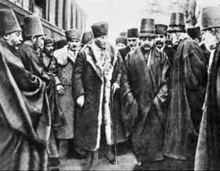
Picture - In 1923, with members of the Mevlana order before its institutional expression became illegal and their dervish lodge changed into the Mevlana Museum. The Mevlevi order managed to transform itself into a nonpolitical organization which still exists.
On 30 August 1925, Mustafa Kemal's view on religious insignia used outside places of worship was introduced in his Kastamonu speech. This speech also had another position. He said:
On 2 September the government issued a decree closing down all Sufi orders and the tekkes. Mustafa Kemal ordered their dervish lodges to be converted to museums, such as Mevlana Museum in Konya. The institutional expression of Sufism became illegal in Turkey; a politically neutral form of Sufism, functioning as social associations, was permitted to exist.
The abolition of the caliphate and other cultural reforms were met with fierce opposition. The conservative elements were not happy and they launched attacks on the Kemalist reformists.
Opposition to Kemal in 1924-1927
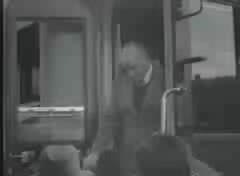
Picture - Ataturk during one of his Anatolian tours.
In 1924, while the "Issue of Mosul" was on the table, Sheikh Said Piran began to organize the Sheikh Said Rebellion. Sheikh Said Piran was a wealthy Kurdish Tribal chief of a local Naqshbandi order. Piran emphasized the issue of religion; he not only opposed the abolition of the Caliphate, but also the adoption of civil codes based on Western models, the closure of religious orders, the ban on polygamy, and the new obligatory civil marriage. Piran stirred up his followers against the policies of the government, which he considered anti-Islamic. In an effort to restore Islamic law, Piran's forces moved through the countryside, seized government offices and marched on the important cities of ElazÄ±Ä and Diyarbakır. Members of the government saw the Sheikh Said Rebellion as an attempt at a counter-revolution. They urged immediate military action to prevent its spread. The "Law for the Maintenance of Public Order" was passed to deal with the rebellion on 4 March 1925. It gave the government exceptional powers and included the authority to shut down subversive groups, but was repealed on 4 March 1929.
There were also parliamentarians in the GNA who were not happy with these changes. So many members were denounced as opposition sympathizers at a private meeting of the Republican People's Party (CHP) that Mustafa Kemal expressed his fear of being among the minority in his own party. He decided not to purge this group. After a censure motion gave the chance to have a breakaway group, Kazım Karabekir, along with his friends, established such a group on 17 October 1924. The censure became a confidence vote at the CHP for Mustafa Kemal. On 8 November, the motion was rejected by 148 votes to 18, and 41 votes were absent. CHP held all but one seat in the parliament. After the majority of the CHP chose him Mustafa Kemal said, "the Turkish nation is firmly determined to advance fearlessly on the path of the republic, civilization and progress".
On 17 November 1924, the breakaway group established the Progressive Republican Party (PRP) with 29 deputies and the first multi-party system began. The PRP's economic program suggested liberalism, in contrast to the state socialism of CHP, and its social program was based on conservatism in contrast to the modernism of CHP. Leaders of the party strongly supported the Kemalist revolution in principle, but had different opinions on the cultural revolution and the principle of secularism. The RPR was not against Mustafa Kemal's main positions as declared in its program; they supported establishing secularism in the country and the civic law, or as stated, "the needs of the age" (article 3) and the uniform system of education (article 49). These principles were set by the leaders at the onset. The only legal opposition became a home for all kinds of differing views.
During 1926, a plot to assassinate Mustafa Kemal was uncovered in Ä°zmir. It originated with a former deputy who had opposed the abolition of the Caliphate. Investigation shifted from an inquiry into the planners to an investigation ostensibly to uncover subversive activities but in truth used to undermine those disagreeing with Kemal's cultural revolution. The sweeping investigation brought a number of political activists before the tribunal, including Karabekir, the leader of PRP. A number of surviving leaders of the Committee of Union and Progress, who were at best second-rank in the Turkish movement, including Cavid, Ahmed Åx¼krx¼, and Ismail Canbulat, were found guilty of treason and hanged. The investigations found a link between the members of the PRP and the Sheikh Said Rebellion. The PRP was dissolved following the outcomes of the trial. The pattern of organized opposition, however, was broken. This action was the only broad political purge during Ataturk's presidency. Mustafa Kemal's saying, "My mortal body will turn into dust, but the Republic of Turkey will last forever," was regarded as a will after the assassination attempt.
Modernization efforts, 1926-1930
In the years following 1926, Mustafa Kemal introduced a radical departure from previous reformations established by the Ottoman Empire. For the first time in history, Islamic law was separated from secular law, and restricted to matters of religion. Mustafa Kemal said
On 1 March 1926, the Turkish penal code was passed. It was modelled after the Italian Penal Code. On 4 October 1926, Islamic courts were closed. Establishing the civic law needed time, so Kemal delayed the inclusion of the principle of lax¯cité until 5 February 1937.
Ottoman practice discouraged social interaction between men and women in keeping with Islamic practice of sex segregation. Mustafa Kemal began developing social reforms very early, as was evident in his personal journal. He and his staff discussed issues like abolishing the veiling of women and the integration of women into the outside world. The clue on how he was planning to tackle the issue was stated in his journal on November 1915;
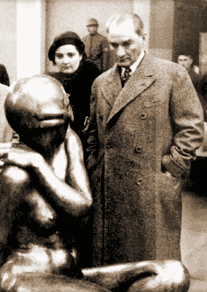
Picture - President Kemal at the 1927 opening of the State Art and Sculpture Museum.
Mustafa Kemal needed a new civil code to establish his second major step of giving freedom to women. The first part was the education of girls and was established with the unification of education. On 4 October 1926, the new Turkish civil code passed. It was modelled after the Swiss Civil Code. Under the new code, women gained equality with men in such matters as inheritance and divorce. Mustafa Kemal did not consider gender a factor in social organization. According to his view, society marched towards its goal with men and women united. He believed that it was scientifically impossible for him to achieve progress and to become civilized if the gender separation continued as in Ottoman times. During a meeting he declaimed:
In 1927, the State Art and Sculpture Museum (Turkish: Ankara Resim ve Heykel Mx¼zesi) opened its doors. The museum highlighted sculpture, which was little practised in Turkey owing to the Islamic tradition of avoiding idolatry. Kemal believed that "culture is the foundation of the Turkish Republic." and described modern Turkey's ideological thrust as "a creation of patriotism blended with a lofty humanist ideal." He included both his own nation's creative legacy and what he saw as the admirable values of global civilization. The pre-Islamic culture of the Turks became the subject of extensive research, and particular emphasis was laid upon Turkish culture widespread before the Seljuk and Ottoman civilizations. He instigated study of Anatolian civilizations--Phrygians and Lydians, Sumerians and Hittites. To attract current public attention to past cultures, he personally named the "Sx¼merbank" (1932) after the Sumerians, and the "Etibank" (1935) after the Hittites. He also stressed the folk arts of the countryside as a wellspring of Turkish creativity.
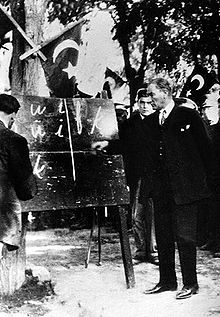
Picture - President Gazi Mustafa Kemal introducing the new Turkish alphabet to the people of Kayseri (20 September 1928.)
In the spring of 1928, Mustafa Kemal met in Anakara with several linguists and professors from all over Turkey where he unveiled to them a plan of his to implement a new alphabet for the written Turkish language based on a modified Latin alphabet. The new Turkish alphabet would serve as a replacement for the old Arabic script and as a solution to the literacy problem in Turkey. When he asked how long it would take to implement the new alphabet into the Turkish language, most of the professors and linguists said between three to five years. Kemal was said to have scoffed and openly stated, "we shall do it in three to five months".
Over the next several months, Mustafa Kemal pressed for the introduction of the new Turkish alphabet as well as made public announcements to the upcoming overhaul of the new alphabet. On 1 November 1928, Mustafa Kemal introduced the new Turkish alphabet and abolished the use of Arabic script. At the time, literate citizens of the country comprised as little as 10% of the population. Dewey noted to Kemal that learning how to read and write in Turkish with the Arabic script took roughly three years with rather strenuous methods at the elementary level. They used the Ottoman Language written in the Arabic script with Arabic and Persian loan vocabulary. The creation of the new Turkish alphabet as a variant of the Latin alphabet was undertaken by the Language Commission (Turkish: Dil Encx¼meni) with the initiative of Mustafa Kemal. The tutelage was received from an Ottoman-Armenian calligrapher. The first Turkish newspaper using the new alphabet was published on 15 December 1928. Kemal himself travelled the countryside in order to teach citizens the new alphabet. The country's adaptation to the new alphabet was very quick, and literacy in Turkey jumped from 10% to over 70% within two years. Beginning in 1932, the People's Houses (Turkish: Halk Evleri) opened throughout the country in order to meet the requirement that people between the ages of four and 40 were required to learn the new alphabet as mandated. There were congresses for discussing the issues of copyright, public education and scientific publishing. Literacy reform was also supported by strengthening the private publishing sector with a new law on copyrights.
Mustafa Kemal promoted modern teaching methods at the primary education level, and Dewey took a place of honour. Dewey presented a paradigmatic set of recommendations designed for developing societies that are moving towards modernity in his "Report and Recommendation for the Turkish educational system." He was interested in adult education for the goal of forming a skill base in the country. Turkish women were taught not only child care, dress-making and household management, but also skills needed to join the economy outside the home. Turkish education became a state-supervised system, which was designed to create a skill base for the social and economic progress of the country. His "unified" education program was designed to educate responsible citizens as well as useful and appreciated members of society. Turkish education became an integrative system, aimed to alleviate poverty and used female education to establish gender equality.
Mustafa Kemal generated media attention to propagate modern education during this period. He instigated official education meetings called "Science Boards" and "Education Summits." to discuss the quality of education, training issues and certain basic educational principles. He said, "our schools [curriculum] should aim to provide opportunities for all pupils to learn and to achieve." He was personally engaged with the development of two textbooks. The first one was Turkish: VatandaÅ Ä°x§in Medeni Bilgiler (1930). The second, Geometry (1937), was a text for high schools. The VatandaÅ Ä°x§in Medeni Bilgiler (Civic knowledge for the citizens) introduced the science of comparative government and explained the means of administering public trust by explaining the rules of governance as applied to the new state institutions.
Opposition to Kemal in 1930-1931
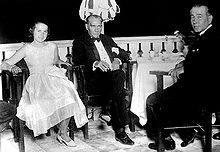
Picture - Mustafa Kemal with the Liberal Republican Party leader Ali Fethi Okyar and his daughter in Yalova, on 13 August 1930.
On 11 August 1930, Mustafa Kemal decided to try a multiparty movement once again and asked Ali Fethi Okyar to establish a new party. He insisted on the protection of secular reforms. The brand-new Liberal Republican Party succeeded all around the country. Without the establishment of a real political spectrum, once again, the party became the center to opposition of Ataturk's reforms, particularly in regard to the role of religion in public life.
On 23 December 1930, a chain of violent incidents occurred, starting with the rebellion of Islamic fundamentalists in Menemen, a small town in the Aegean region. This so-called Menemen Incident was considered a serious threat against secular reforms.
In November 1930, Ali Fethi Okyar dissolved his own party. A more lasting multi-party period of the Republic of Turkey began in 1945. In 1950, the RPP released the majority position to the Democratic Party. There are arguments that Kemal's single party rule did not promote direct democracy. The experiments with pluralism failed during this period was that not all groups in the country had agreed to a minimal consensus regarding shared values (mainly secularism) and shared rules for conflict resolution. In response to such criticisms, Mustafa Kemal's biographer Andrew Mango said: "between the two wars, democracy could not be sustained in many relatively richer and better-educated societies. Ataturk's enlightened authoritarianism left a reasonable space for free private lives. More could not have been expected in his lifetime." Even though, at times, he did not appear to be a democrat in his actions, he always supported the idea of building a civil society: a system of voluntary civic and social organizations and institutions as opposed to the force-backed structures of the state. In one of his many speeches about the importance of democracy, Mustafa Kemal said in 1933:
Modernization efforts, 1931-1938
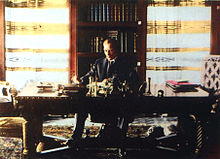
Picture - Ataturk at the library of the xankaya Presidential Residence in Ankara, 1929.
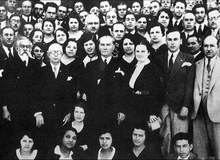
Picture - In 1931, during the establishment ceremony of the Turkish History Institution.
In 1931, Mustafa Kemal established the Turkish Language Association for conducting research works in the Turkish language (Turkish: Tx¼rk Dil Kurumu). The Turkish Historical Society (Turkish: Tx¼rk Tarih Kurumu) was established in 1931, and began maintaining archives in 1932 for conducting research works on the history of Turkey. On 1 January 1928, he established the Turkish Education Association. The Association supported intelligent and hard-working children in financial need, as well as making material and scientific contributions to the educational life.
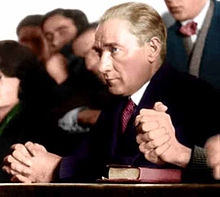
Picture - Attending a class at the Law School of the Istanbul Darx¼lfx¼nunu in 1930.
In 1933, Mustafa Kemal Ataturk ordered the reorganization of Istanbul University into a modern institution and later established Ankara University in the capital city.
Mustafa Kemal dealt with the translation of scientific terminology into Turkish. He wanted the Turkish language reform to be methodologically based. Any attempt to "cleanse" the Turkish language of foreign influence without modelling the integral structure of the language was inherently wrong to him. He personally oversaw the development of the Sun Language Theory (Turkish: Gx¼neÅ Dil Teorisi), which was a linguistic theory which proposed that all human languages were descendants of one Central Asian primal language. His interest started with the works by the French scientist Hilaire de Barenton entitled L'Origine des Langues, des Religions et des Peuples, which postulates that all languages originated from hieroglyphs and cuneiform used by Sumerians, and the paper of Austrian linguist Dr. Hermann F. KvergiÄ of Vienna entitled "La psychologie de quelques elements des langues Turques" ("the psychology of some elements of the Turkic Languages"). He introduced the Sun Language Theory into Turkish political and educational circles in 1935, although he did later correct the more extremist practices.
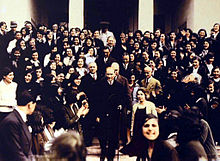
Picture - Ataturk visits the Istanbul University after its reorganization with the University Law of 31 May 1933 that introduced mixed-sex education to the academies, colleges and universities in Turkey. In 1915, during the Ottoman period, a separate section for girl students named the Ä°nas Darx¼lfx¼nunu was opened as a branch of the Ä°stanbul Darx¼lfx¼nunu, the predecessor of the modern Istanbul University.
Beginning in 1932, several hundred "People's Houses" (Turkish: Halk Evi) and "People's Rooms" (Halk Odası) across the country allowed greater access to a wide variety of artistic activities, sports, and other cultural events. Ataturk supported and encouraged the visual and the plastic arts, which had been suppressed by the Ottoman leaders, who regarded depiction of the human form as idolatry. Many museums opened, architecture began to follow modern trends, and classical Western music, opera, and ballet, as well as the theatre, also took greater hold. Book and magazine publications increased as well, and the film industry began to grow.
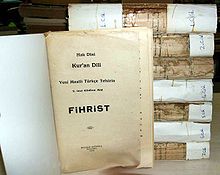
Picture - The original 1935 print of the first Quran in Turkish language, ordered by Ataturk.
In 1932, a Qur'an in the Turkish language was read before a live audience and broadcast over the radio. That same year, Mustafa Kemal wanted to "teach religion in Turkish to Turkish people who had been practising Islam without understanding it for centuries" All Qur'ans at the time were printed in Old Arabic. There was a rare polyglot Qu'ran written in Arabic, Persian, Turkish and Latin in the tetrapla style, prepared by savant Andrea Acolutho of Bernstadt and printed at Berlin in 1701. In 1924, three Turkish translations published in Istanbul created controversy. Several renderings of the Qur'an in the Turkish language were read in front of the public. These Turkish Qur'ans were fiercely opposed by religious people. This incident impelled many leading Muslim modernists to call upon the Turkish Parliament to sponsor a Qur'an translation of suitable quality. With the support of Mustafa Kemal, the Parliament approved the project and the Directorate of Religious Affairs enlisted, Mehmet Akif (Ersoy), to compose a Qur'an translation and a Islamic scholar Elmalılı Hamdi Yazır to author a Turkish language Qur'anic commentary (tafsir) titled "Hak Dini Kur'an Dili." It was only in 1935 that the version read in public found its way to print. Mustafa Kemal believed that the understanding of religion was too important to be left to a small group of people. This included the central religious text of Islam. Mustafa Kemal's objective was to make the Qu'ran accessible to modern people, and therefore to translate it into modern languages.
In 1934, Mustafa Kemal commissioned the first Turkish operatic work, xzsoy. The opera, which was staged at the People's House in Ankara, was composed by Adnan Saygun and performed by soprano Semiha Berksoy.
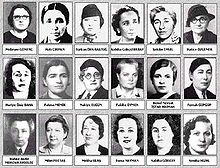
Picture - Eighteen female MPs joined the Turkish Parliament with the 1935 general elections.
On 5 December 1934, Turkey moved to grant full political rights to women, before several other European nations. The equal rights of women in marriage had already been established in the earlier Turkish civil code. Women's place in Mustafa Kemal's cultural reforms was best expressed in the civic book prepared under his supervision. Mustafa Kemal said that
Change came slowly; in the 1935 elections there were only 18 female MPs out of a total of 395 representatives.
Foreign policies
Ataturk's foreign policy followed his motto, "peace at home and peace in the world." a perception of peace linked to his project of civilization and modernization. The outcomes of Kemal's policies depended on the power of the parliamentary sovereignty established by the Republic. The Turkish War of Independence was the last time Ataturk used his military might in dealing with other countries. Foreign issues were resolved by peaceful methods during his presidency.
Issue of Mosul
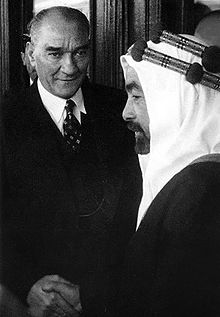
Picture - During the visit of Abdullah I of Jordan.
The "Issue of Mosul", a dispute with the United Kingdom over control of Mosul Province, was one of the first foreign affairs-related controversies of the new Republic. During the Mesopotamian campaign, General Marshall followed the British War Office's instruction that "every effort was to be made to score as heavily as possible on the Tigris before the whistle blew", capturing Mosul three days after the signature of the Armistice of Mudros (30 October 1918). In 1920, the Misak-ı Milli, which consolidated the "Turkish lands", declared that Mosul Province was a part of the historic Turkish heartland. The British were in a precarious situation with the Issue of Mosul, and were adopting almost equally desperate measures to protect their interests. The Iraqi revolt against the British was put down by the RAF Iraq Command during the summer of 1920. From the British perspective, if Mustafa Kemal Ataturk stabilized Turkey, he would then turn his attention to Mosul and penetrate Mesopotamia, where the native population would probably join him thus bringing an insurgent and hostile Muslim nation to the very gates of India.
In 1923, Mustafa Kemal tried to persuade the GNA that accepting the arbitration of the League of Nations at the Treaty of Lausanne over Mosul did not mean relinquishing Mosul, but rather waiting for a time when Turkey might be stronger. The artificially drawn border had an unsettling effect on both sides of the population. Later, it was claimed that Turkey began where the oil ends as the border was drawn by the British geophysicists based on the oil reserves. Ataturk did not want this separation. The British Foreign Secretary attempted to disclaim any existence of oil in the Mosul area. On 23 January 1923, Lord Curzon argued that the existence of oil was no more than hypothetical. However, according to Armstrong, "England wanted oil. Mosul and Kurds were the key."
While three inspectors from the League of Nations Committee were sent to the region to oversee the situation in 1924, the Sheikh Said rebellion, beginning in 1924 and escalating until 1927, set out to establish a new government positioned to cut Turkey's link to Mesopotamia. The relationship between the rebels and Britain was questioned. British assistance was sought after the rebels realised that the rebellion, or its expected outcome, could not stand by itself.
In 1925, the League of Nations formed a three-member committee to study the case while the Sheikh Said Rebellion was on the rise. Partly because of the continuing uncertainties along the northern frontier (present-day northern Iraq), the committee recommended that the region should be connected to Iraq with the condition that the UK would hold the British Mandate of Mesopotamia. By the end of March 1925, the necessary troop movements were completed, and the whole area of the Sheikh Said rebellion was encircled. As a result of these manoeuvres, the revolt was put down. Britain, Iraq and Kemal made a treaty on 5 June 1926, which mostly followed the decisions of the League Council. In 1926, Kemal faced growing opposition to his reform policies, a continuing precarious economic situation, and a defeat in the Mosul issue. A large section of the Kurdish population and the Iraqi Turkmen were left on the other side of the border. The Sheikh Said Rebellion hastened both the imposition of the Republican Party and the speed of Ataturk's reforms. In 1925, the population was largely illiterate and disparate. Turkey was in ruins, reconstruction was difficult, poverty was everywhere and people were in pain, which fed separatist violence. Mustafa Kemal attributed the rebellion to certain notables rather than a section of the population, who had been found guilty by the courts (kanunen mucrim olan bazi muteneffizan) and who used the mask of religion to conceal the interests of landlords, feudal tribal leaders and other "reactionaries" on 7 March 1925.
Relations with the RSFSR/Soviet Union

Picture - During a reception at the USSR Embassy in Ankara, on 7 November 1927.
In his message to Vladimir Lenin, Russian bolsheviks' leader and head of the RSFSR's government, dated 26 April 1920, Kemal promised to coordinate his military operations with the Bolsheviks' "fight against imperialist governments" and requested 5 million lira in gold as well as armaments "as first aid" to his forces. In 1920 alone, the Lenin government supplied the Kemalists with 6,000 rifles, over 5 million rifle cartridges, 17,600 projectiles as well as 200.6 kg of gold bullion; in the subsequent 2 years the amount of aid increased.
In March 1921, the GNA representatives in Moscow signed the "Friendship and Brotherhood" Treaty with Soviet Russia, which was a major diplomatic breakthrough for the Kemalists. The Treaty of Moscow, followed by the identical Treaty of Kars in October the same year, gave Turkey a favourable settlement of its north-eastern frontier at the expense the Armenian Soviet Socialist Republic, then nominally an independent state.
The two country's relations were friendly but were based on the fact that they were fighting against a common enemy: Britain and the West. In 1920, Kemal toyed with the idea to use a state-controlled Turkish Communist Party to forestall the perceived spread of communist ideas in the country and gain access to the Comintern's financing; nevertheless, the entire Turkish communist leadership were assassinated on 28 January 1921 at Kemal's behest.
"Friendship with Russia," said Mustafa Kemal, "is not to adopt their ideology of communism for Turkey." He declared: "Communism is a social issue. Social conditions, religion, and national traditions of our country confirm the opinion that Russian Communism is not applicable in Turkey." In a 1 November 1924 speech he said: "Our amicable relations with our old friend the Soviet Russian Republic are developing and progressing every day. As in past our Republican Government regards genuine and extensive good relations with Soviet Russia as the Keynote of our foreign policy."
After the Turks, on 16 December 1925, withdrew their delegation from Geneva, thus leaving the League of Nations Council to grant a mandate for the Mosul region to Britain without their consent, Kemal countered by concluding a non-aggression pact with the USSR on 17 December the same year. In 1935, the pact was prolonged for another 10 years.
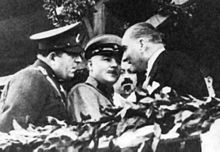
Picture - Exchanges on the concept of a Balkan Federation during the visit of Voroshilov, a vision of Kemal's which was never achieved.
In 1933, the Soviet War minister Kliment Voroshilov visited Turkey and attended the tenth year celebrations of the Republic. Kemal explained his position regarding the realization of his plan for a Balkan Federation economically uniting Turkey, Greece, Romania, Yugoslavia and Bulgaria.
During the second half of the 1930s, Mustafa Kemal tried to establish a closer relationship with Britain and other major western powers, which caused displeasure on the part of the Soviets. The second edition of the Great Soviet Encyclopedia (Volume 20, 1953) was unequivocally critical of Kemal's policies in the last years of his rule, calling his domestic policies "anti-popular" and his foreign course as aimed at rapprochement with the "imperialist powers."
Turkish-Greek alliance
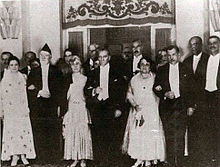
Picture - Hosting the Greek Prime Minister Eleftherios Venizelos (at left) in October 1932.
The post-war leader of Greece, Eleftherios Venizelos, was also determined to establish normal relations between the two states. The war devastated Western Anatolia, and the financial burden of Ottoman Muslim refugees from Greece blocked rapprochement. Venizelos moved forward with the agreement despite accusations of conceding too much on the issues of the naval armaments, and the properties of the Ottoman Greeks from Turkey according to the Treaty of Lausanne. Kemal resisted the pressures of historic enmities or atrocity-mongering between the societies. In spite of Turkish animosity against the Greeks, Kemal showed acute sensitivity to even the slightest allusion to these tensions; at one point, he ordered the removal of a painting showing a Turkish soldier plunging his bayonet to a Greek soldier by stating, "What a revolting scene!".
Ultimately, many Greeks consider the reconciliation with Turkey among the greatest foreign policy achievements of Venizelos' final term as Prime Minister. Greece renounced all its claims over Turkish territory and the two sides concluded an agreement on 30 April 1930. On 25 October, Venizelos visited Turkey, and signed a treaty of friendship. Venizelos even forwarded Ataturk's name for the 1934 Nobel Peace Prize, Even after his fall from power, Greco-Turkish relations remained cordial. Indeed, Venizelos' successor Panagis Tsaldaris came to visit Ataturk in September 1933 and signed a more comprehensive agreement, called the Entente Cordiale, a stepping stone for the Balkan Pact.
Greek Premier Ioannis Metaxas said of Ataturk and the Turkish-Greek alliance, that "...Greece, which has the highest estimation of the renowned leader, heroic soldier, and enlightened creator of Turkey. We will never forget that President Ataturk was the true founder of the Turkish-Greek alliance based on a framework of common ideals and peaceful cooperation. He developed ties of friendship between the two nations which it would be unthinkable to dissolve. Greece will guard its fervent memories of this great man, who determined an unalterable future path for the noble Turkish nation."
Neighbours to the east
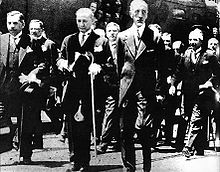
Picture - During the visit of Faisal I of Iraq in 1931.
From 1919, Afghanistan was in the midst of a reformation period under Amanullah Khan. Afghan Foreign Minister Mahmud Tarzi was a follower of Mustafa Kemal's domestic policy. He encouraged Amanullah Khan in social and political reform but urged that reforms should build upon the basis of a strong government. During the late 1920s, Anglo-Afghan relations soured over British fears of an Afghan-Soviet friendship. On 20 May 1928, Anglo-Afghan politics gained a positive perspective, when Amanullah Khan and the Queen were received by Mustafa Kemal in Constantinople. This meeting was followed by a Turkey-Afghanistan Friendship and Cooperation pact on 22 May 1928. Mustafa Kemal supported Afghanistan's integration into international organizations. In 1934, Afghanistan's relations with the international community gained a huge boost when it joined the League of Nations. In 1937, King Zahir Shah became a signatory of the Treaty of Saadabad. Mahmud Tarzi received Mustafa Kemal's personal support until he died on 22 November 1933 in Istanbul.
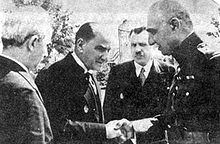
Picture - During the visit of Reza Pahlavi I, The Shah of Iran.
Mustafa Kemal and Reza Shah had a common approach regarding British imperialism and its influence in their region, creating a slow but continuous rapprochement between Ankara and Tehran. Both governments sent diplomatic missions and messages of friendship to each other during the Turkish war of independence. The policy of the Ankara government in this period was to give moral support in order to assure Iranian independence and territorial integrity. The relations were strained after the abolishment of the Caliphate. Iran's Shi'a clergy did not accept Kemal's position. Iranian religious power centres perceived the real motive behind Ataturk's reforms was to undermine the power of the clergy. An admirer of Mustafa Kemal and close student of his reforms, Reza Shah followed the same type of modernization efforts. By the mid-1930s, Reza Shah's efforts had upset the clergy throughout Iran, thus widening the gap between religion and government. Mustafa Kemal feared the occupation and dismemberment of Iran as a multi-ethnic/multi-tribal society by Russia or Great Britain. Like Mustafa Kemal, Reza Shah wanted to secure Iran's borders. Reza Shah visited him in 1934. In 1935, the draft of what would become the Treaty of Saadabad was paragraphed in Geneva, but the signing of it was delayed because of the border dispute between Iran and Iraq. Iran challenged the validity of both the Treaty of Erzerum and the Constantinople Protocol in 1934.
On 8 July 1937, Turkey, Iraq, Iran and Afghanistan signed the Saadabad Pact at Tehran. The signatories undertook to preserve their common frontiers, to consult together in all matters of common interest and to commit no aggression against one anotherâs territory. The treaty united the Afghan kingâs call for greater Oriental-Middle Eastern cooperation, Reza Shah's goal in securing relations with Turkey that would help Iran free herself from Soviet and British influence, and Mustafa Kemal's foreign policy of securing stability in the region. The immediate outcome was to deter Mussolini from adventures in the region.
Turkish Straits
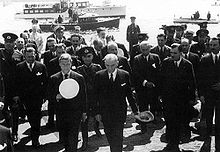
Picture - During the visit of King Edward VIII.
On 24 July 1923, the Treaty of Lausanne included the Lausanne Straits Agreement. The Lausanne Straits Agreement stated that the Dardanelles should remain open to all commercial vessels: seizure of foreign military vessels was subject to certain limitations during peacetime, and, even as a neutral state, Turkey could not limit any military passage during wartime. The Lausanne Straits Agreement stated that the waterway was to be demilitarized, and its management left to the Straits Commission. The demilitarized zone heavily restricted Turkey's domination and sovereignty over the Straits. The defence of Constantinople was impossible without having the sovereignty over the water that passed through it.
In March 1936, Hitler's reoccupation of the Rhineland gave Mustafa Kemal the opportunity to resume full control over the Straits. "The situation in Europe", he declared "is highly appropriate for such a move. We shall certainly achieve it". Tevfik Rx¼Åtx¼ Aras, who was the foreign minister, initiated a move to revise the Straits' regime. Aras claimed that he was directed by the President, rather than his Prime Minister, Ismet Inx¶nx¼. InÅnx¼ was worried about harming relations with Britain, France, and Balkan neighbors over the Straits. However, the signatories agreed to join the conference, since unlimited military passage had become unfavourable to Turkey with the changes in world politics. Mustafa Kemal demanded that the members of the Turkish Foreign Office devise a solution that would transfer full control over the waterway to Turkey.
On 20 July 1936, the Montreux Convention was signed, with the participation of Bulgaria, Great Britain, Australia, France, Japan, Romania, the Soviet Union, Turkey, Yugoslavia and Greece. It became the primary instrument governing the passage of commercial and war vessels through the Dardanelles Strait. It was ratified by the GNAT on 31 July 1936. It went into effect on 9 November 1936, and is still valid today.
Balkan Pact
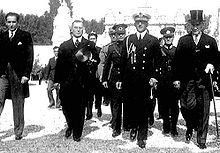
Picture - During the visit of Alexander I of Yugoslavia in 1931.
Until the early 1930s, Turkey followed a modern neutral foreign policy with the West by developing joint friendship and neutrality agreements. These bilateral agreements were aligned with Mustafa Kemal's worldview. By the end of 1925, Turkey had signed fifteen joint agreements with Western states.
In the early 1930s, changes and developments in world politics required Turkey to make multilateral agreements to improve its security. Mustafa Kemal strongly believed that a close cooperation between the Balkan states based on the principle of equality would have an important effect on European politics. These states had been ruled by the Ottoman Empire for centuries, and had formed a powerful force. While the origins of the Balkan agreement may date back as far as 1925, the Balkan Pact came to being in the mid-1930s. Several important developments in the Balkan Peninsula and in Europe helped the original idea to materialize, such as improvements in the Turkish-Greek alliance and the rapprochement between Bulgaria and Yugoslavia.
The Balkan Pact was negotiated by Mustafa Kemal with Greece, Romania, and Yugoslavia. This mutual-defence agreement intended to guarantee the signatories' territorial integrity and political independence against attack by another Balkan state such as Bulgaria or Albania. It countered the increasingly aggressive foreign policy of fascist Italy and the effect of a potential Bulgarian alignment with Nazi Germany. He thought of the Balkan Pact as a medium of balance in the relations with the European countries. Mustafa Kemal was particularly anxious to establish a region of security and alliances in the west of Turkey and in Balkan Europe, which would extend as far as Dobruja.
The Balkan Pact provided for regular military and diplomatic consultations. It was regarded as a significant step forward in consolidating the free world's position in southeast Europe, although it contained no specific military commitments. The importance of the agreement was best displayed in the message which Ataturk sent to the Greek Premier, Ioannis Metaxas:
It was signed by GNA on 28 Feb. The Greek and Yugoslav Parliaments ratified the agreement a few days after. The unanimously ratified Balkan pact became a reality on 18 May 1935 and lasted until 1940.
The Balkan Pact turned out to be ineffective for reasons that were beyond Ataturkâs control. What he wanted to prevent with the Balkan Pact was realized by Bulgariaâs attempt to put the Dobruja issue into the agenda after a series of international events ending with the Italian invasion of Albania on 7 April 1939. These conflicts spread rapidly, ending with World War II. The goal of Ataturk, to protect southeast Europe, failed with the dissolution of the pact. The only state which arose intact after the war was Ataturk's Republic of Turkey.
Issue of Hatay
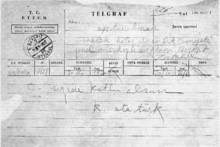
Picture - Telegram sent by Ataturk after the local legislative assembly accepted his proposal for the Hatay State's flag.
Turkish Prime-Minister Ismet Inonu was very conscious of foreign policy issues. During the second half of the 1930s, Ataturk tried to form a closer relationship with Britain. The risks of this policy change put the two men at odds. The Hatay issue and the Lyon agreement were two important developments in foreign policy that played a significant role in the severing of relations between Ataturk and Ismet.
In 1936, Ataturk raised the "Issue of Hatay" at the League of Nations. Hatay was based on the old administrative unit of the Ottoman Empire called the Sanjak of Alexandretta. On behalf of the League of Nations, the representatives of France, the United Kingdom, the Netherlands, Belgium and Turkey prepared a constitution for Hatay, which established it as an autonomous sanjak within Syria. Despite some inter-ethnic violence, in the midst of 1938 an election was conducted by the local legislative assembly. The cities of Antakya (Antioch) and Ä°skenderun (Alexandretta) joined Turkey in 1939.
Economic policies
For conceptual analysis, see Economic reforms
Mustafa Kemal instigated economic policies to develop small and large scale businesses, but also to create social strata (industrial bourgeoisie along with the peasantry of Anatolia) that were virtually non-existent during the Ottoman Empire. The primary problem faced by the politics of his period was the lag in the development of political institutions and social classes which would steer such social and economic changes. Mustafa Kemal's vision regarding early Turkish economic policy was apparent during the Ä°zmir Economic Congress of 1923 which was established before the signing of the Lausanne Treaty. The initial choices of Mustafa Kemal's economic policies reflected the realities of his period. After World War I, due to the lack of any real potential investors to open private sector factories and develop industrial production, Kemal established many state-owned factories for agriculture, machinery, and textile industries.
State intervention, 1923-1929
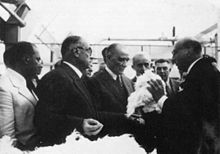
Picture - Ataturk and Celx¢l Bayar visiting the Bursa plant, which was established as a part of the cotton-related industry.
Mustafa Kemal and Ä°smet Ä°nx¶nx¼ pursuit of state controlled economical policies was guided by a national vision; they wanted to knit the country together, eliminate the foreign control of the economy, and improve communications. Constantinople, a trading port with international foreign enterprises, was abandoned and resources were channelled to other, less developed cities, in order to establish a more balanced development throughout the country.
For Mustafa Kemal, as for his supporters, tobacco remained wedded to his policy in the pursuit of economic independence. Turkish tobacco was an important industrial crop, while its cultivation and manufacture were French monopolies under capitulations of the Ottoman Empire. The tobacco and cigarette trade was controlled by two French companies: the "Regie Compagnie interessee des tabacs de l'empire Ottoman" and "Narquileh tobacco." The Ottoman Empire gave the tobacco monopoly to the Ottoman Bank as a limited company under the "Council of the Public Debt". Regie, as part of the Council of the Public Debt, had control over production, storing, and distribution (including export) with an unchallenged price control. Consequently, Turkish farmers were dependent on the company for their livelihood. In 1925, this company was taken over by the state and named "Tekel". The control of tobacco was the biggest achievement of the Kemalist political machinery's "nationalization" of the economy for a country that did not produce oil. They accompanied this achievement with the development of the cotton industry, which peaked during the early 1930s. Cotton was the second biggest industrial crop in Turkey.
In 1924, with the initiative of Mustafa Kemal, the first Turkish bank İŠBankası was established. He was the first member of İŠBankası. The bank's creation was a response to the growing need for a truly national establishment and the birth of a banking system which was capable of backing up economic activities, managing funds accumulated as a result of policies providing savings incentives and, where necessary, extending resources which could trigger industrial impetus.
In 1927, Turkish State Railways was established. Because Mustafa Kemal considered the development of a national rail network as another important step in industrialization, it was given high priority. This institution developed an extensive railway network in a very short time. In 1927, Kemal also ordered the integration of road construction goals into development plans. The road network consisted of 13,885 km of ruined surface roads, 4.450 km of stabilized roads, and 94 bridges. In 1935, a new entity was established under the government called "Sose ve Kopruler Reisligi" which would drive development of new roads after World War II. However, in 1937, the 22,000 km of roads in Turkey augmented the railways.
The national group, which had Kemal as the leader, developed many projects within the first decade of the republic. However, the Turkish economy was based on agriculture, with primitive tools and methods; roads and transportation facilities were far from sufficient and management of the economy was inefficient. The Great Depression brought many changes to this picture.
Great Depression, 1929-1931
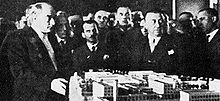
Picture - Ataturk supported large-scale government subsidized industrial complexes, such as Sx¼merbank, increasingly after the Great Depression.
The young republic, like the rest of the world, found itself in a deep economic crisis during the Great Depression. Mustafa Kemal reacted to conditions of this period by moving toward integrated economic polices, and establishing a central bank to control exchange rates. However, Turkey could not finance essential imports; its currency was shunned and zealous revenue officials seized the meagre possessions of peasants who could not pay their taxes.
In 1929, Mustafa Kemal signed a treaty that resulted in the restructuring of the nation's debt with the Ottoman Public Debt Administration. He did not fault the Ottoman debt. He had to deal with the turbulent economic issues of the Great Depression along with the payment of the high debt known as the Ottoman public debt. Until the early 1930s, Turkish private business could not acquire exchange credits. It was impossible to integrate the Turkish economy without a solution to this problem. This increased the credibility of the new Republic.
In 1931, Mustafa Kemal's intention to establish the Central Bank of the Republic of Turkey was realized. The bank's primary purpose was to have control over the exchange rate, and Ottoman Bank's role during its initial years as a central bank was phased out. Later specialized banks such as the Sx¼merbank (1932) and the Etibank (1935) were founded.
From the political economy perspective, Mustafa Kemal had to face the same problems which all countries faced: political upheaval. The establishment of a new party with a different economic perspective was needed; he asked Ali Fethi Okyar to fulfil. The Liberal Republican Party (August, 1930) came out with a liberal program and proposed that state monopolies should be ended, foreign capital should be attracted, and that state investment should be curtailed. Mustafa Kemal supported Ä°nx¶nx¼'s point of view: "it is impossible to attract foreign capital for essential development." In 1931, he proclaimed: "In the economic area ...the programme of the party is statism." However, the effect of free republicans was felt strongly and state intervention became more moderate, more akin to a form of state capitalism. One of his radical left-wing supporters, Yakup Kadri KaraosmanoÄlu from the Kadro (The Cadre) movement, claimed that Mustafa Kemal found a third way between capitalism and socialism.
Liberalization and planned growth, 1931-1939
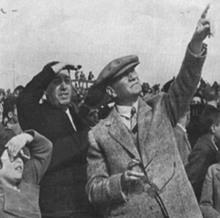
Picture - Ataturk at the Etimesgut Airport in Ankara, built by the Turkish Aircraft Association. His famous quote, "the future is in the skies", is embossed today on the airport's fax§ade.
The first (1929-1933) and second five year economic plans were performed under the supervision of Mustafa Kemal. The first five year economic plan promoted consumer substitution industries. However, these economic plans changed drastically with the death of Kemal and the rise of World War II. Subsequent governments took measures that harmed the economic productivity of Turkey in various ways. The achievements of the 1930s were credited to early (1920s) implementation of the economic system based on the national policies of Mustafa Kemal and his team.
In 1931, Mustafa Kemal watched the first national aircraft, MMV-1, develop. He realized the important role of aviation. In his words, "the future lies in the skies". Turkish Aeronautical Association was founded in 16 February 1925 by his directive. He ordered the establishment of the Turkish Aircraft Association Lottery. Instead of the traditional raffle prizes, this new lottery paid money prizes. The major part of its income was used to establish a new factory fund aviation projects. Mustafa Kemal did not see the flight of the first Turkish military aircraft built at the factory. Operational American Curtiss Hawk fighters were being produced soon after his death and before the onset of World War II.
In 1932, liberal economist Celal Bayar became the Minister of Economy at Mustafa Kemal's request and served until 1937. During this period, the country moved toward a mixed economy with its first private initiatives. Textile, sugar, paper and steel factories (financed by a loan from Britain) were the private sectors of the period. Besides these government owned power plants, banks, and insurance companies were established.
In 1935, the first Turkish cotton print factory "Nazilli Calico print factory" opened. Cotton planting was promoted to furnish raw material for future factory settlements, part of the industrialization process. Nazilli became a major center beginning with the establishment of cotton mills and was followed by a calico print factory by 1935.
In 1936 Nuri DemiraÄ established the first Turkish aircraft factory in the BeÅiktaÅ district of Istanbul. The first Turkish airplanes, Nu D.36 and Nu D.38, were produced in this factory.
On 25 October 1937, Mustafa Kemal appointed Celal Bayar as the prime minister of the 9th government. Integrated economic policies reached their peak with the signing of the 1939 Treaty with Britain and France. This signaled a turning point in Turkish history. It was the first step towards an alliance with the "West". Celal Bayar served as prime minister until Mustafa Kemal's death. The differences of opinion between Inx¶nx¼ (state control) and Celal Bayar (liberal) came to the forefront after Ä°nx¶nx¼ became president in 1938. On 25 January 1939, Prime Minister Bayar resigned.
Mustafa Kemal supported the establishment of the automobile industry. He wanted it to become a center in the region. The motto of the Turkish automobile association was: "The Turkish driver is a man of the most exquisite sensitivities."
During 1935, Turkey was becoming an industrial society on the Western European model set out by Ataturk. At the time of his death, most regions of Turkey had viable micro-economic stability and some macro economic stability. These signs of sound economic policies were marked by the first-ever emergence of local banks. However, the gap between Mustafa Kemalâs goals and the achievements of the socio-political structure of the country was not closed.
Personal life
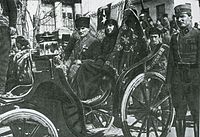
Picture - Mustafa Kemal (Ataturk) and his wife Lx¢tife UÅaklıgil (UÅÅaki) in Afyonkarahisar, March 23, 1923.
On 29 January 1923, Mustafa Kemal married Latife UÅaklıgil; they were divorced on 5 August 1925. He never remarried. During his lifetime, Ataturk adopted twelve daughters and a son. In his leisure time, he enjoyed reading and writing (books and a personal journal), horseback riding, chess, and swimming. He was also an avid dancer and enjoyed both the waltz and traditional Zeybek folk dances.
During 1937, indications that Ataturk's health was worsening started to appear. In early 1938, while he was on a trip to Yalova, he suffered from a serious illness. He went to Ä°stanbul for treatment, where he was diagnosed with cirrhosis of the liver due to heavy alcohol consumption. During his stay in Ä°stanbul, he made an effort to keep up with his regular lifestyle for a while. He died on 10 November 1938, at the age of 57, in the Dolmabahx§e Palace, where he spent his last days. The clock in the bedroom where he died is still set to the time of his death, 9:05 in the morning. Ataturk's funeral called forth both sorrow and pride in Turkey, and seventeen countries sent special representatives, while nine contributed armed detachments to the cortx¨ge. Mustafa Kemal's remains were originally laid to rest in the Ethnography Museum of Ankara, and transferred on 10 November 1953, 15 years after his death in a 42-ton sarcophagus, to a mausoleum that overlooks Ankara, Anıtkabir. In his will, he donated all of his possessions to the Republican People's Party, providing that the yearly interest of his funds would be used to look after his sister Makbule and his adopted children, and fund the higher education of the children of Ä°smet Ä°nx¶nx¼. The remainder of this yearly interest was willed to the Turkish Language Association and the Turkish Historical Society.
Legacy
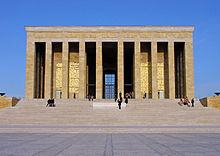
Picture - Anıtkabir, the mausoleum of Kemal Ataturk, in Ankara, Turkey.
Turkey
Mustafa Kemal Ataturk is commemorated by many memorials throughout Turkey, such as the Ataturk International Airport in Istanbul, the Ataturk Bridge over the Golden Horn (Halix§), the Ataturk Dam, and Ataturk Stadium. Ataturk statues have been erected in all Turkish cities by Turkish Government, and most towns have their own memorial to him. His face and name are seen and heard everywhere in Turkey; his portrait can be seen in all public buildings, in all schools and classrooms, on all school books, on all Turkish lira banknotes, and in the homes of many Turkish families. At the exact time of his death, on every 10 November, at 09:05 a.m., most vehicles and people in the country's streets pause for one minute in remembrance.
Outlawing insults to his reminiscence
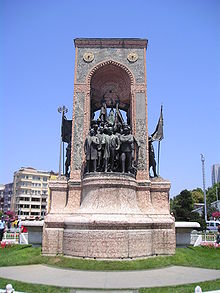
Picture - Ataturk's statues are erected in every town of Turkey. The Monument of the Republic, crafted by the famous Italian sculptor Pietro Canonica, is located at the Taksim Square in Istanbul.
In 1951, the Turkish Parliament issued a law (5816) outlawing insults to his reminiscence (Turkish: Hatırası) or destruction of objects representing him. The demarcation between a criticism and an insult was defined as a political argument and the minister of Justice (a political position) was assigned in Article 5 to execute the law rather than the public prosecutor. A government website [2] was created to denounce the websites that violate this law.
In 2007 Youtube, Geocities, and several blogger webpages were blocked by a Turkish court due to the violation of this law. The YouTube ban in the country lasted for 30 months, in reitaliation for four videos on Atatx¼r. In the last week of October 2010, a German company, following a request from the Turkish Internet Board, exploited YouTube automatic copyright-enforcement mechanism to take down the videos. On October 30, shortly after the removal, a court lifted the ban. But a few days later, Google concluded that the videos did not infringe copyright and restored them on youtube.
In 2010 the French-based NGO Reporters Without Borders declared that the Turkish laws to protect the memory of Kemal Ataturk are in contradiction with the current European Union standards of freedom of speech in news media.
Worldwide
In 1981, the centennial of Ataturk's birth, his memory was honoured by the United Nations and UNESCO, which declared it The Ataturk Year in the World and adopted the Resolution on the Ataturk Centennial. The Ataturk Memorial in Wellington, New Zealand (which also serves as a memorial to the ANZAC troops who died at Gallipoli); the Ataturk Memorial in the place of honour on ANZAC Parade in Canberra, Australia; the Ataturk Forest in Israel; and the Ataturk Square in Rome, Italy, are only a few examples. He has roads named after him in several countries, like the Kemal Ataturk Marg in New Delhi, India, Kemal Ataturk Avenue in Dhaka, Bangladesh, the Ataturk Avenue in the heart of Islamabad in Pakistan, the Ataturk Road in the southern city of province of Sindh of Pakistan called Larkana where Ataturk visited back in 1923, Mustafx¡ Kemal Ataturk street in the Naco district of Santo Domingo, Dominican Republic, and the street and memorial Ataturk in the Amsterdam-Noord borough of Amsterdam, Netherlands. The entrance to Princess Royal Harbour in Albany, Western Australia is named Ataturk Channel. Barack Obama, the 44th President of the United States, who visited his tomb and praised him, also expressed his view regarding Ataturk's legacy at his speech towards "the Muslim world" by stating Ataturk's "greatest legacy is Turkey's strong and secular democracy, and that is the work that this assembly carries on today."
Kemalism
Revolution
State socialism
Young Turks
Pan Turkism
List of people on the cover of Time Magazine: 1920s - 24 Mar. 1923
Chronology of the Turkish War of Independence
List of high-ranking commanders of the Turkish War of Independence
Prints
Ahmad, Feroz (1993). The Making of Modern Turkey. London; New York: Routledge. ISBN 978-0415078351.
Armstrong, Harold Courtenay (1972). Grey Wolf, Mustafa Kemal: An Intimate Study of a Dictator. Freeport, NY: Books for Libraries Press. ISBN 978-0836969627.
Atillasoy, Yx¼ksel (2002). Ataturk: First President and Founder of the Turkish Republic. Woodside, NY: Woodside House. ISBN 978-0971235342.
Barber, Noel (1988). Lords of the Golden Horn: From Suleiman the Magnificent to Kemal Ataturk. London: Arrow. ISBN 978-0099539506.
Barlas, Dilek (1998). Statism and Diplomacy in Turkey: Economic and Foreign Policy Strategies in an Uncertain World, 1929-1939. New York: Brill Academic Publishers. ISBN 978-9004108554.
Cleveland, William L (2004). A History of the Modern Middle East. Boulder, Colorado: Westview Press. ISBN 978-0813340487.
DoÄan, xaÄatay Emre (2003) (in Turkish). Formation of Factory Settlements Within Turkish Industrialization and Modernization in 1930s: Nazilli Printing Factory. Ankara: Middle East Technical University. OCLC 54431696.
Huntington, Samuel P. (2006). Political Order in Changing Societies. New Haven, Conn.; London: Yale University Press. ISBN 978-0300116205.
Ä°Ädemir, UluÄ; Mango, Andrew (translation) (1963). Ataturk. Ankara: Turkish National Commission for UNESCO. pp. 165-170. OCLC 75604149.
Ä°nan, AyÅe Afet (2007) (in Turkish). Ataturk Hakkında Hatıralar ve Belgeler. Istanbul: Tx¼rkiye Ä°Å Bankası Kx¼ltx¼r Yayınları. ISBN 9944881401.
Ä°nan, AyÅe Afet; Sevim, Ali; Sx¼slx¼, Azmi; Tural, M Akif (1998) (in Turkish). Medeni bilgiler ve M. Kemal Ataturk'x¼n el Yazıları. Ankara: AKDTYK Ataturk AraÅtırma Merkezi. ISBN 978-9751612762.
Kinross, Patrick (2003). Ataturk: The Rebirth of a Nation. London: Phoenix Press. ISBN 978-1842125991. OCLC 55516821.
Kinross, Patrick (1979). The Ottoman Centuries: The Rise and Fall of the Turkish Empire. New York: Morrow. ISBN 978-0688080938.
Landau, Jacob M (1983). Ataturk and the Modernization of Turkey. Boulder, Colorado: Westview Press. ISBN 978-0865319868.
Lengyel, Emil (1962). They Called Him Ataturk. New York: The John Day Co. OCLC 1337444.
Mango, Andrew (2002) [1999]. Ataturk: The Biography of the Founder of Modern Turkey (Paperback ed.). Woodstock, NY: Overlook Press, Peter Mayer Publishers, Inc. ISBN 1-58567-334-x.
Mango, Andrew (2004). Ataturk. London: John Murray. ISBN 978-0719565922.
Saikal, Amin; Schnabel, Albrecht (2003). Democratization in the Middle East: Experiences, Struggles, Challenges. Tokyo: United Nations University Press. ISBN 978-9280810851. http://books.google.com/?id=qFhU3kWXLvEC&printsec=frontcover&dq=ataturk+and+islam.
Shaw, Stanford Jay; Shaw, Ezel Kural (1976-1977). History of the Ottoman Empire and Modern Turkey. Cambridge; New York: Cambridge University Press. ISBN 978-0521212809.
Spangnolo, John (1992). The Modern Middle East in Historical Perspective: Essays in Honour of Albert Hourani. Oxford: Middle East Centre, St. Antony's College. ISBN 978-0863721649. OCLC 80503960.
Tunx§ay, Mete (1972) (in Turkish). Mesax® : Halk Åx»rx¢lar Fırkası Programı, 1920. Ankara: Ankara xniversitesi Siyasal Bilgiler Fakx¼ltesi. OCLC 1926301.
Tx¼fekx§i, Gx¼rbx¼z D (1981). Universality of Ataturk's Philosophy. Ankara: Pan Matbaacılık. OCLC 54074541.
Yapp, Malcolm (1987). The Making of the Modern Near East, 1792-1923. London ; New York: Longman. ISBN 978-0582493803.
Webster, Donald Everett (1973). The Turkey of Ataturk; Social Process in the Turkish Reformation. New York: AMS Press. ISBN 978-0404563332.
Zx¼rcher, Erik Jan (2004). Turkey: A Modern History. London; New York: I.B. Tauris. ISBN 978-1850433996.
Journals
Eastham, J. K. (March 1964). "The Turkish Development Plan: The First Five Years". The Economic Journal (New York: Macmillan) 74 (298): 132-136. doi:10.2307/2228117. ISSN 0013-0133. http://jstor.org/stable/2228117.
Emrence, Cem (2003). "Turkey in Economic Crisis (1927-1930): A Panaromic Vision". Middle Eastern Studies (London: F. Cass.) 39 (4): 67-80. doi:10.1080/00263200412331301787. ISSN 0026-3206.
Omur, Aslı (December 2002). "Modernity and Islam: Experiences of Turkish Women". Turkish Times 13 (312). ISSN 1043-0164. http://www.theturkishtimes.com/archive/02/12_01/c_women.html. Retrieved 2007-10-10.
xzelli, M. Tunx§ (January 1974). "The Evolution of the Formal Educational System and its Relation to Economic Growth Policies in the First Turkish Republic". International Journal of Middle East Studies (London: Cambridge University Press) 5 (1): 77-92. ISSN 0020-7438. JSTOR 162345.
Stone, Norman (2000). "Talking Turkey". The National Interest (New York: National Affairs, Inc) 61: 66. ISSN 0884-9382.
Volkan, Vamik D. (1981). "Immortal Ataturk - Narcissism and Creativity in a Revolutionary Leader". Psychoanalytic Study of Society (New York: Psychohistory Press) 9: 221-255. ISSN 0079-7294. OCLC 60448681.
Wolf-Gazo, Ernest (1996). "John Dewey in Turkey: An Educational Mission". Journal of American Studies of Turkey (Ankara, Turkey: American Studies Association of Turkey) 3: 15-42. ISSN 1300-6606. http://www.bilkent.edu.tr/~jast/Number3/Gazo.html.
"Mustafa Kemal Ataturk". TP Editors: pp. 7-8. http://www.teknikportal.com/mustafa-kemal-ataturk-hayati-basarilari-t9870.0.html. Retrieved 2008-04-29.
"The Burial of Ataturk". Time Magazine: pp. 37-39. 23 November 1953. http://www.time.com/time/magazine/article/0,9171,860125,00.html. Retrieved 2007-08-07.
More aircraft.
Source: WikiPedia